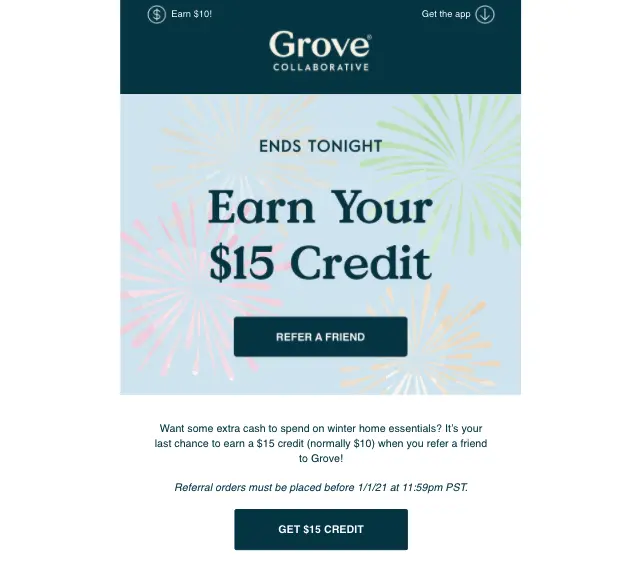Referrals have been around for years – and we all rely on them. When you bought a product after a family member or friend recommended it to you – that’s a referral. And referral marketing works – here’s why:
Humans tend to stick to what we know and like best. This is why recommendations and reviews come in handy before buying a product or signing up for a service.
As a result, business owners put a significant effort into referral marketing when building a marketing strategy. It’s a modern way of adding to the phenomenally powerful “WOM” (word-of-mouth) strategy, and that’s always a good way to go.
Referral programs can be run across multiple communication channels, but referral emails are the most popular and preferred programs. This is because we are exposed to email every day. And we can easily sign up for incentives using quick links or share information with loved ones in seconds. It’s a great way of getting results rapidly and effectively.
In this post, we’ll be discussing how to create a powerful referral email program and how you can make the program build as smoothly as possible.
But before we can proceed with anything more, let’s understand the concept of referral emails first.
What is a referral email?
A referral email is a specific email you send to positive and happy customers. These emails are designed to encourage these customers to refer their friends and family to your business. Referrals are based on the idea that if one customer enjoys a product or service from you, they will advocate for your company by telling others to use the same product or service and get a positive experience.
From a business point of view, referral emails are a preferred method because it’s quick to set up and run to customer segments as and when you wish. In addition, email marketing software can help you create and use referral email templates. These email templates equip you with pre-formatted or pre-written materials, ready to go whenever you need to send a referral email.
Importance of referrals in business growth
Referrals have been a critical part of business for many years. This is because potential customers tend to trust their family, friends, and colleagues more than anyone regarding recommendations. Here are a few stats to show just how powerful referrals can be:
92% of people trust referrals from individuals they know. Consumers are also more likely to purchase when referred by a family member or friend. (Nielsen)
It’s clear that when a prospective customer needs that last “nudge” to hit the purchase button, it’s very effective when it comes to them as a referral from a friend. Referral marketing campaigns can also be robust and exciting for businesses to run, with campaigns including incentives, rewards, referral bonuses, etc. All these tactics form part of your referral strategy.
So, let’s get into the details of referral email strategies next.

Understanding Referral Email Strategies
We have deduced how imperative referral strategies are. But when you look at email as a specific communication channel, it’s important to understand what steps you should take to run a smooth, consistent, and successful referral email strategy. We’ve outlined five steps you should take when crafting your referral email strategy:
1. Setting clear objectives for referral emails
Setting SMART goals is the best way to start a referral marketing program. SMART (Specific, Measurable, Attainable, Relevant, and Time-bound) goals help you set clear objectives and help you focus the campaign, and guide it through its phases. A lack of well-defined goals can affect the overall revenue of your business and muddies the water when it comes to understanding your company, product, and customer goals. An example of a goal would be:
– Generating 45 new referrals in the next three months.
– Increasing your referral email campaign click-through rates from 15% to 20% within the next four months.
As you can see, each goal has specific numbers and timeframes linked to them. This makes them SMART.
2. Identifying target audience and referral sources
This is where you will identify all your customers who will likely refer people to your business. This can be a range of customers, so thoroughly background research is important here. Here are some parameters you can look at to try and identify the most appropriate customers for your referral program:
– Are these customers your repeat customers?
– Are they your long-standing customers?
– Are they customers who buy primarily on promotions?
By taking the time to understand your target audience, you are establishing data segments you can tailor messaging to. Referral marketing software can help you set up several customer segments and target automated personalized messages to them.
3. Crafting compelling messaging and value proposition
The next step is all about crafting a compelling message. This is where you can be creative and use your skills to entice customers from the moment they open your email.
When building your referral email template with copy and images, it’s a good idea to ensure they’re easy to see, read, and understand. Have a single and clear CTA (call-to-action). This will help keep your customer focused on the task at hand. Remember, your goal should be to get the referral and only that. Don’t confuse clients with many actions to take across one email. Instead, make it clear what action you want your target audience to take.
4. Choosing the right incentives for referrals
Everyone knows that a referral that includes incentives are always more enticing. But not every incentive will work for referrals, so analyze which ones will be best for your target audience.
Firstly, you should bear in mind that there are plenty of incentive options to choose from, including free products or services, discounts, cash rewards, etc. Remember that incentives must be selected based on your available budget and resources. Every “cashed-in” incentive should be covered by the business and accounted for when calculating revenue and expenses.
5. Implementing tracking and analytics for effective measurement
Lastly, you should use referral marketing software to help track and monitor the results of your campaign. A reporting and analytics feature should allow you to track what’s working and not in your referral program.
It’s a good idea to keep track of your key metrics so you can analyze wins, losses and make informed decisions for future referral campaigns. Analyzing results can also help refine your incentives and message for existing referral campaigns. To be successful, you should aim for continuous improvement in your referral program.
Building a Referral Email Campaign
Now that we’ve discussed referral email strategies in detail, it’s time to address the question you’re most likely asking yourself: “How can I build a referral email campaign that is effective and successful?” Let’s dive in.

Step 1: Establishing campaign goals and timelines
Similar to the SMART goals step, you will need to set out and establish your campaign goals as well as timelines. To do so, you’ll need to outline the following:
– Who is my target audience?
– What is the outline of this specific referral campaign?
– How many steps does this referral campaign contain?
– How will you measure the campaign?
– How long will the campaign run?
Once these questions are answered, your referral campaign goals and timelines will be defined. These should be referred to before, during, and after your campaign run.
Step 2: Create an enticing subject line and preheader text
The next step is to come up with an inviting subject line as well as preheader text. These are the first elements of the referral email your client will see. So, it could define if they even open your email or not. You must take the time to come up with an exciting and enticing subject line. Here are a few examples of subject lines that are alluring and will surely get people interested in the email:
– Welcome to ABC Gym. Here’s your referral code!
– Get 20% off any merch when you refer a friend – XYZ Yoga Studio
– Exclusive: Refer 2 friends and get 1 free Smart Thermostat! – 123Smart
Here’s an example of a referral email with a great subject line and preheader text:
Grove
Subject: Your $15 offer is expiring.

Image Source: Milled
Step 3: Designing a visually appealing email template
The design of your email should always match your brand look, style, and design guidelines. In other words, the fonts, colors, graphic elements, white space, etc., should be recognizable to recipients. Luckily, with referral program management software, you have access to email templates. These allow you to create an overall template with your branding and reuse it for multiple emails.
Your referral email should always be visually appealing and focus the customer on your CTA. Below is an excellent example of how a referral email is visually stunning and still effective with a powerful CTA:

Image Source: Really Good Emails
Step 4: Personalizing referral emails for better engagement
Once you have your referral email template set up, it’s time to look at personalizing your emails to make them more relevant and enticing. Why? Because personalization is possibly the most critical component of marketing today.
With access to advanced automated tools today, personalization can be achieved quickly and efficiently. Moreover, consumers are now expecting it. So, take some time to account for tailoring messages for clients – especially in referral campaigns.
You can implement personalization in many areas of the email, such as the subject line or email body. You can even choose to send an email with a personalized code on their birthday.
Step 5: Incorporating social proof and testimonials
When you have your referral email subject line, body copy, design, imagery, personalization, and CTA all confirmed, it’s time to add the last bit of special information – testimonials.
The truth is that people love a success story. It makes them feel like someone has gone through the process and had a positive experience, enticing them to follow a similar path. This is why testimonials can be so powerful in referral emails. It’s a good idea to request feedback from customers who have used your referral program and share this positive feedback in emails to prospective referees. Keep all testimonials banked for present and future referral email campaigns.
Step 6: Optimizing for mobile devices and different email clients
This step is a more technical one, but it’s just as important as all the former steps. You must ensure all referral emails are legible and optimized for various mobile devices. Screen sizes, resolutions, etc., all matter regarding emails on a mobile device. The last thing you want is a referral email loading with half the information cut off on the side. To ensure your emails are set optimally, check them against mobile device best practices or consult your email marketing software company for advice.
Step 7: Testing and iterating on email content and design
Finally, you should always test your emails. There is nothing worse than one email being broadcasted to hundreds of customers with a broken link or a cut-off image. Before you broadcast your emails, send a test email to a staff member. Try to test emails on several devices to ensure accuracy across the board.
In addition to testing, you should also aim to constantly evolve when it comes to content and design. This helps your customers get a better experience each time and allows your business to strive for excellence with every email sent out.
Effective Referral Email Templates
1. Referral request email template
This is the most common and general referral request. Try using the following email template:
Hi, [customer name],
Thanks for being part of our gang! We hope you enjoy using this [product/service] and that it’s worth sharing with family and friends.
Did you know you can invite friends and get [incentive] for your next purchase?
Simply share the link below to redeem this [incentive].
[insert link/call-to-action button]
Sincerely,
[business name]
2. Thank you and confirmation email template
This email should be sent when a referral has been completed. Keep it short and sweet, but let the customer have all the relevant information on hand in one confirmation email:
Hi, [customer name],
Thanks so much for referring your friend to our [business]! We’re so excited to welcome them!
Here’s a summary of your next steps:
– You’ve referred a friend and have received [incentive]
– Your friend will receive [incentive]We love our customers dearly, and your feedback is so helpful to us.
If you have a few moments, kindly answer a quick survey, we’d be very grateful.
[insert link to survey]
Sincerely,
[business name]
3. Reminder and follow-up email templates
These emails are usually sent as a follow-up to the initial email to a client. They are generally a quick reminder email to the customer with a simple CTA at the end:
Hi, [customer name],
We know how busy your days get, and we’re here for you. We sent some information about our referral program a while ago. If you’re interested in referring a friend, click the link below.
[insert link/call-to-action button]
If you have any questions about the program, feel free to email or call us.
Sincerely,
[business name]
4. Referral incentive delivery email template
This referral email template can be used for customers who are receiving their referral incentives. Here’s an example:
Nice job!
Your friend [friend name] just joined [product/service]! Now the community is a little bigger, and you’re qualified for additional exclusive referral credit!
Click the link below to unlock your credit and enjoy it today!
[insert link/call-to-action button]
Sincerely,
[business name]
5. Referral program update and progress email template
The last referral email template is one that speaks to updates and progress on a referral. Below is a sample of what this could look like:
Head’s up! $20 pending…
Your friend [friend name] has just received an exclusive referral deal.
When they place their first order with us, as a thank you to you, we’ll add referral credit to your account. You can spend this whenever you like, on whatever you like on our site!
You can keep an eye on your progress below.
[insert call-to-action button]
Sincerely,
[business name]
Best Practices for Referral Emails
1. Ensuring clarity and simplicity in email copy
There are several best practices you can use for referral emails. One of them is ensuring that your email copy is precise, simple, and clear. This is because you want to make sure your referral programs, incentives, and anything related are clear. You want your customer to read the email quickly and easily (on desktop, tablet, or mobile devices) and click your call-to-action button.
2. Highlighting the benefits of referring
Ensure that you explain your referral program, how it works, and the benefits of referring. Often people think of referral programs as ones where a business is asking you for more business via referrals – and that’s true. But they often don’t realize what’s in it for them – and you must explain this to them when communicating.
3. Making it easy to share referrals
Shareability is one of the most significant aspects of referral emails. You want to increase the chances of engagement between friends and family members. And the best way to do so is to choose buttons, images, and links that are visually appealing and appropriate for sharing across social media and other communication platforms.
4. Leveraging urgency and exclusivity
Another referral email best practice is to ensure that you’re always playing up your business’s value proposition and creating a sense of urgency for customers. Make it known that they have been hand-picked for this exclusive referral offer. This will help create a sense of personalization and exclusiveness – making customers feel appreciated for their loyalty.
5. Establishing trust and credibility
You should also take this opportunity to build trust between yourself and the customer. They are already loyal to you and see your brand in a positive light – so use this opportunity to get them closer to the advocate stage. Remember, advocates are the golden nugget – and referral email campaigns can help you get there.
6. Personalizing and segmenting referral emails
As mentioned before, personalization is a massive theme regarding referral programs and marketing in general. By using premium referral email marketing software, you can be sure that your messages will be personalized and audiences segmented based on the specific criteria you choose. This is where the power of marketing automation truly comes in.
7. Analyzing and optimizing referral email performance
The last best practice is all about analysis. It’s important to measure your performance and campaign results to know where your wins and losses are. Referral email campaigns should always be continuously tweaked so you’re constantly getting closer to achieving your campaign goals and objectives.(SMART goals – remember? You should always come back to them!)
FAQs
1. Why should I use referral emails in my marketing strategy?
Referral emails help you engage with your most loyal and long-standing customers and ask them to help you grow your business. It creates a high customer lifetime value.
2. What are the key elements of an effective referral email?
You should have a compelling subject line and sub-heading, simple and bold copy, imagery, social share features, and one CTA (call-to-action). You can use a referral email template to save time.
3. How can I encourage recipients to refer others in my referral emails?
Create referral email campaigns with incentives to help entice recipients. You can also personalize time-based emails and offer exclusive deals to create a sense of urgency and exclusivity.
4. Can I track the effectiveness of my referral emails?
Yes, you can use referral marketing software to monitor and track the performance of your campaigns. This is a best practice and should be done for every campaign.
Get the full story here:


